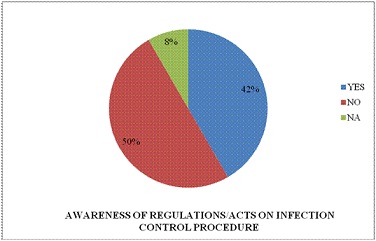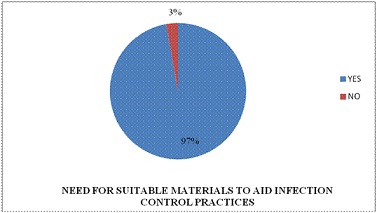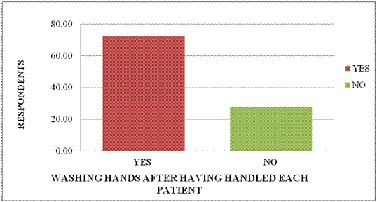Original Article

Infection Control by Radiographers during Radiological Examinations in Ghana
*William KwodwoAntwi * Kofi AdesiKyei * James Gawugah, *Samuel Yaw Opoku,2Lawrence Arthur, 2 Gladys Baah,
- *Department of Radiography, College of Health Sciences, Greater Accra, Accra, Ghana
- Submitted: Monday, October 27, 2014
- Accepted: Sunday, April 26, 2015
- Published: Saturday, May 16, 2015
This is an Open Access article distributed under the terms of the Creative Commons Attribution License (http://creativecommons.org/licenses/by/3.0), which permits unrestricted use, distribution, and reproduction in any medium, provided the original work is properly cited
Abstract
Background
Practicing infection control in hospitals with the aim of preventing and reducing the spread of infectious diseases in the hospital environment of which the radiology department is of no exception is critical. This is to ensure the safety of staff and patients against contracting any disease from infection directly or indirectly during any hospital encounter.
Aim
To assess the appropriate use of infection control principles/measures by radiographers during practice and to also establish whether infection control guidelines are necessary.s
Patients & Methods
A descriptive quantitative survey was carried out among radiographers within three selected hospital in Ghana. In all 72 radiographers consented to participate in the study. A structured questionnaire assessing demographic characteristics, knowledge of infection control and the necessity of infection control guidelines of the respondents were completed. Data collected were then entered into Microsoft Excel 2007.
Results
Out of the72 participants recruited to participate in the study, the majority (78%) were males. All the respondent were aware of infection control guidelines that needed to be observed in order to reduce the spread of infections but only 89% enforced its practice during the course of work.
Conclusion
The participants were aware of infection control guidelines but several of them failed to apply these procedures during course of work.
Key words
Infection; Microorganisms; Sterilization; Post Exposure prophylaxis
Introduction
Infection control is the discipline concerned with preventing the spread of infection within the health care setting [1]. It is a practical sub discipline of epidemiology which is akin to public health practice and is practiced within the confines of a particular health-care delivery system rather than directed to a society as a whole [2].
Basically infection control is about preventing the transmission of infection through the hospital and this is an essential part of clinical practice [3]. Health care professionals are therefore expected to apply and or implement the concepts and procedures for infection control during their practice in their various specialities. All healthcare practitioners are expected to be responsible for compliance with the infection control precautions [4]. According to Fox & Harvey [5], the diagnostic imaging department is central within the hospital to the diagnosis of all illnesses and diseases. In other to prevent a situation whereby patients acquire infection in the hospital setting or department, it is important to apply the principles of infection control [6]. Healthcare professional ethics demand that infection control principles/procedures be adhered to and therefore should not be disregarded for safety of the patients, colleagues and other health care practitioners [3]. It is in this vein that a better understanding of infection control principles is important for radiographers. There is therefore the need for more study into the area of infection control in order to guide the radiographer in his professional practice.
Infection control in health care settings is essential for the safety of patients, their families, and healthcare workers [7]. Although several studies have been done in Ghana to assess the rate of infection control measures, information on radiographers association with infection control is inadequate. Hence, the need for a study in area of infection control principles/measures in Ghana to assess the possible factors needed to reduce infection and to also establish the existence of possible guidelines in the practice of radiography.
Purpose
To assess the appropriate use of infection control principles/measures by radiographers during practice and to also establish whether infection control guidelines are necessary.
Objectives
1.To ascertain the use of infection control measures by radiographers in the x-ray department.
2.To find out if there are separate guidelines to help reduce infection control during x-ray examinations.
3.To find out if radiographers are aware of the existence of protocols and legislation concerning infection control
Methodology
A quantitative design, using a descriptive survey, was chosen as it provided the quickest way to gather information from the population. It is also one of the most common forms of research which provides a lot of numerical data and easier to analyze the data collected [8]. The study was carried out in three (3) selected hospitals among radiographers in Ghana. Convenient sampling method was used to obtain the participants for study and all qualified radiographers at the study sites were selected as the sample size. All student radiographers and interns were excluded from this study.
structured questionnaire. The questionnaire was constructed under three sections, namely, section A, B and C. Section A was designed to collect demographic data of respondents. Section B however sought to gather information on the knowledge of infection control while section C gathered data on the practice of infection control among the radiographers. The questionnaires were personally distributed by the researcher and were given to participants by hand. Completed questionnaires were personally collected from participants. Data collected were collected and entered into Microsoft Excel 2007. The results generated were presented in tabular and graphical forms.
Approval for the study was obtained from the research ethics committee of a higher education institution. The ethics approval was supported by written permission for the study to be conducted at the study site. All study participants gave informed consent prior to the commencement of the study.
Results
In all, 72 questionnaires were completed, out of which there was a response rate of 84%. Out of 72 respondents, 56 were males while 16 were females. Majority of the respondent (38) had worked up to 4 years and only 8% had worked for over 15years. All the participants (72) believed that there is the need for infection control guidelines in their practicing areas.78% of the respondents had idea on infection control guidelines and 22% had no idea at all. Eighty nine percent respondents enforced infection control procedures during practice [Figure 1]. Almost 78% indicated that cleaning and disinfecting of x-ray couches in between patients were a protocol in their units
(Table 1).

Figure 1: Infection control procedure enforcement during practice
|
|
RESPONDENTS
|
PERCENTAGE (%)
|
|
YES
|
56
|
77.8
|
|
NO
|
16
|
22.2
|
|
TOTAL
|
72
|
100
|
It was noted that all the respondents had a fair knowledge on infection control at their various units and although 78% respondents indicated that they wash their hands after handling each [Figure 4], only half (50%) of the respondents were aware of regulations/acts on infection control guidelines and 42% had no knowledge [Figure 2]. Ninety-seven percent (97%) of the respondents were however of the view that there was the need for suitable materials while 3% did not need materials to aid infection control practices in Ghana. A total of78% of the respondents indicated they had training in infection control procedures but 22% indicated otherwise. Almost all the respondents (94%) believed that there was the need for training in the use of infection control guidelines [Figure 5].

Figure 2: Awareness of regulations/Acts on infection control procedure

Figure 3: Need for suitable materials to aid infection control practices

Figure 4: Washing hands after having handled each patient
Discussion
Infection control practices come with many issues such as knowledge on infection control, infection control measures, written guidelines on infection control, measures adopted to protect healthcare professionals and legal issues concerning infection control. According to Mauricio, Monsalve, Sriram,
et al, [9], the incubation period is the first stage that occurs prior to the occurrence of signs and symptoms and as such an individual may be able to spread the disease to others during this stage of the incubation period. The findings of the study depicted that majority of the radiographers in the metropolis were males. This situation could largely be attributed to unwillingness of a greater number woman to remain in the Radiography Profession for years, because of their knowledge of the long term effects radiation and its health implications. With regards to working experience, 53% of the participants have had four or lesser years of working experience. It could however be inferred that minority of the respondents (47%) therefore have gained better practical experience in the practice of radiography with respect to their years of working experience.
Knowledge on infection control practices
All the radiographers who took part in the study felt that there was the need for written guidelines in their departments. On the issue of awareness of guidelines in their departments, only 22% of the respondents were not aware of the guidelines. Perhaps both the law makers and hospital management were not communicating effectively to these radiographers and they felt there was no monitoring undertaken to make sure the right things were done in the various hospitals.
Eighty nine of the respondents claimed they practice infection control as part of their current practice [Figure 1]. For those who were unaware of infection control guidelines, the question of how they practiced infection control arose and it was clear that they relied largely on their own general knowledge, and perhaps had sought to their own way of practicing infection control.
It was however worrisome that despite the participants’ knowledge on infection control guidelines, [Figure 2], about 3% refused to enforce these guidelines. Could this discrepancy on the side of the respondents be due to laziness, absence of sinks in the duty rooms, unavailability of water at certain times, high workloads on certain days, and the like? As to whether these are the reasons, the answer remains unidentified.
A substantive number of the respondents (78%) had received training in infection control procedures, yet all respondents, both the trained and untrained agreed there was the need for further training. This need for training could be due to the desire to learn more and keep abreast with improved methods of infection control practices to give them confidence in their professional practice.
Legislation
Legislation concerning infection control practices was well acknowledged by 50% of the respondents. In Ghana, the Radiography profession is not well known at the legislative level though recently there has been a vast improvement with the Allied Health Council and this may be a reason for the lack of specific legislation concerning infection control practices [10]. However, the 1992 Constitution of the Republic of Ghana [11] contain laws pertaining to negligence on the side of the health care professional [Chapter 2, Article 28(4)]. Legislation on infection control practices is essential to guide and shape protocols regarding infection control and also to provide a means of dealing with radiographers who do not conform to the standard and hence are likely to transmit infections to others [10].
Infection control practices
The range of materials to aid in infection control is unsatisfactory for 97% of the respondents [Figure 3]. The materials that were listed as being available included savlon, cotton wool, methylated spirit and disposable gloves. Mauricio,
et al, [10], notedthe significance of hand washing in the prevention of infections during work whiles Zimitat [12] stated that the radiographer should note that in order to be effective, all instruments and equipment used or to be used must be cleaned. This assertion was well acknowledged by a vast majority of personnel, though the minority (22%) did not wash hands after handling of each patient. The trend observed calls for concern as few of the personnel did not practice what is the best and effective method of preventing the spread of diseases as noted by Larson [13].

Figure 5: Need for hepatitis b vaccination by health care professionals
It is thus crucial that the various departments provide more materials needed for proper hand washing in order to reduce incidence of transferring infection from one person to other as a result of not washing hands in between patients.97% of the personnel considered disinfecting and cleaning of couches in between patients as paramount practice. The College of Nurses, Ontario [14] cites disinfection and cleaning as a serious measure of infection control.
Conclusion
Almost half of the radiographers surveyed were aware of infection control procedures but failed to apply them during their course of work. Some of the contributing factors to this included shortage of staff, heavy workload per day, absence of sinks and disposable towels in some duty rooms, absence of infection control guidelines in the departments, late and/or inadequate supply of materials by department to aid in infection control procedures.
The following recommendations were therefore made to the study;
1.Radiographers must be given periodic training in infection control procedures. This could be done through workshops and with the aid of qualified health professionals.
2.Written protocols and legislation must be outlined to monitor the use of infection control procedures during work.
3.There should be an infection control officer who periodically monitors the extent of practice of infection control procedures by Radiographers.
Recommendation
Authors have taking note of the comments of the reviewers in the paper we sent for publication and wish to state that during the period of the study, MRI and CT have not been available in the areas where the study was conducted. Also, barium studies were also not being conducted because of lack of facilities even at the leading teaching hospitals at the time of study. Hence the study covered the areas of practice at that time. Future work will target these areas of study and we strongly recommend this.
Authors’ contributions
GB and KAK carried out the literature and prepared the draft manuscript. SYO, LA and WKA carried out the experiment and JG interpreted the results, KAK and WKA designed the study and performed the analyses SYO conceived the study and participated in the study design and KAK & WKA edited the final manuscript. All authors read the script carefully and approved the final manuscript for submission
Conflict of interests
The authors declare that there are no conflicts of interests
Ethical Considerations
The study was approved by the Institute Ethics committee
Funding
None
References
[1].Boyle H, Strudwick RM. Do lead rubber aprons pose an infection risk, Radiography, 2010; 16, 297-303?
[2].Akosa B. A. Policy and Procedures for Infection Control in Health Facilities. Ghana Health Service Institutional Care Division, 2003; 1:19-33.
[3].Berlin L. Radiologic malpractice Litigation: A view of the Past, a gaze at the Present, a glimpse of the Future: American Journal of Roentgenology, 2003; 181: 1481-1486 [Pubmed]
[4].Huttunen R, Syrjänen J. Healthcare workers as vectors of infectious diseases. Eur J ClinMicrobiol Infect Dis, 2014; 33:1477–1488 [Pubmed]
[5].Fox M, Harvey JM. An investigation of infection control for x-ray cassettes in a diagnostic imaging department. Radiography, 2008; 14:306-311.
[6].Marcel JP, Alfa M, Baquero F,et al. Healthcare-associated infections: think globally, act locally. ClinMicrobiol Infect, 2008; 14: 895–907 [Pubmed]
[7].McCulloch J. Infection control, science, management and practice. London: Whurr Publishers2000
[8].GayLR, Airasain P. Educational Research: Competencies for Analysis and Applications. 7th edition. Upper Saddle River, NJ: Merril Prentice Hall, Hector, Anestine.2003
[9].Mauricio N, Monsalve MS, Sriram V et al. Do Peer Effects Improve Hand Hygiene Adherence among Healthcare Workers? Infection control and hospital epidemiology, 2014; 35(10):1277-1285.
[10].Dashti M, Al-Abbad M, Faleh A, Al-Ostath S. Current Immobilization Implementation of Pediatric Patients in Five Major Public Hospitals in Kuwait: a Prospective Study into Policies and Guidelines for Radiology Departments. Indian Journal of Innovations and Developments,2012; 1(8), India.
[11].Constitution of Ghana, (1992). http://www.politicsresources.net/docs/ghanaconst.pdf
[12].Zimitat, C. Capturing community of practice knowledge for student learning: Innovations in Education and Teaching International,2007; 44(3): 21-32.
[13].Larson, E. L. APIC guidelines for hand washing and hand antisepsis in health care setting. American Journal of Infection Control, 1995; 23(4):251-269
[14].College of Nurses, Ontario. Infection Prevention and Control, publication no. 41002 ISBN 2008; pg 1-89.

